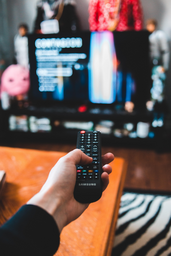A Think Piece on the Nuances of Queer Representation and its Handling in THE Trending TV Scene
A large part of how I’ve relaxed over sophomore year has been Sunday night new episodes of my favorite airing shows. Last semester, I was an eager watcher of House of the Dragon, looking up the latest hit tweets or TikTok edits after each episode, and even watching the occasional video essay too. This semester, I am proudly part of the masses flocking to watch a new hour of The Last of Us every Sunday (seemingly only to get my heart ripped out each time). As viewer numbers break records with each new hit show, it’s a no-brainer that HBO Max is the ruler of the format of the weekly episodes in a TV culture run by streaming services.
But, there’s another thing HBO has made space for that I think is extremely important to acknowledge, and that is casting phenomenal non-binary actors. The latest example is Bella Ramsey, a 19-year-old actor who is starring as Ellie Williams in The Last of Us. Despite initial criticism about their portraying this role, they’ve proved every Sunday night that not only can there be a space for genderqueer actors in the biggest shows on television, but they can shine as well.
Ramsey isn’t the only one, however. The second actor I want to highlight—also starring as the lead of a majorly anticipated show—is Emma D’Arcy, who plays the older version of Rhaenyra Targaryen in House of the Dragon. They have participated in theater and film in the past, but this is their breakout role, which even got them a Golden Globe nomination.
It’s great to simply mention these names and acknowledge that they are being given massive opportunities, but I think digging deeper into their respective roles and the critical acclaim given to them shows that not only are non-binary actors capable of being stars but that their gender identity may in fact add something fresh to their unique portrayals of these characters.
Since acting is its own form of art, I think it is inevitable that any actor will bring some of themselves into their role. Ellie Williams in The Last of Us is a character with a lot of masculine and tough energy, living in a gritty apocalyptic world that she navigates with no remorse. One of the biggest praises given to Ramsey has been the way they portray this character with a confidence and comfort level that in my opinion would be hard-pressed to replicate from an actress whose gender expression lies more in the socially accepted female binary.
Similarly, Rhaenyra Targaryen is described as boyish and wild compared to the society that the Game of Thrones setting requires from royal women. She gravitates to characters that accept this inner fire of hers and sees it as her strength, in comparison to ones that see her lack of feminine conformity as a flaw.
Both actors have spoken about using non-traditional gender expression to be more comfortable in their roles.
“[Bella] told me that she wore a chest binder for ’90 percent’ of shooting The Last of Us… allowing her to focus better on set.”
– Jack King, interviewer and author of Bella Ramsey’s GQ Magazine UK special
“[In other projects], I was in dresses… I was in a corset. And I felt super powerful in that. Playing these more feminine characters is a chance to be something so opposite to myself, and it’s really fun.”
– Bella Ramsey for a special in GQ Magazine UK
Now, what has putting non-binary actors at the center of television done to spark conversation? Some of my own personal anecdotes have made me inclined to believe strongly that keeping non-binary actors on the screen is helping push our society to be more accepting and progressive. For me, this has meant patiently educating those I love about the gender spectrum and seeing the shift on social media as people generally respect the gender identity of these actors without much fuss. Both of these occurrences have led me, and the people along the gender spectrum that I care about, to feel more seen than ever regarding gender identity.
My mom immigrated to the U.S. from Mexico in her 20s and was unable to speak a word of English. Because of the culture she grew up in and the fact that Spanish itself is a gendered language, it has been a privilege for me to be able to answer her questions as she tries to learn. She is an avid TV watcher just like me, and I’ve seen firsthand how talking about these actors and their work has helped change her mind. For example, pronouns that don’t directly correspond to the gender binary are something she feels much more comfortable using.
Having actors in the spotlight that are openly non-binary has also helped her see the reality of a spectrum of gender expression. Even within those I spoke of earlier, Ramsey uses any pronouns and dresses in both feminine and masculine styles of clothing, while D’Arcy uses they/them pronouns exclusively and generally tends to a masculine style. They’ve both also challenged the idea of fluid gender expression by speaking on their experiences. I’ve had many phone conversations where I could literally hear someone begins to pull their mind out of the idea of the gender binary. It is powerful and important, and I can’t stress that enough.
Now that I’ve emphasized that, I’d like to shift gears a little. Netflix has been under hot water for some time, but why did I bring them up in a discussion about queer actors and media? I’ve been praising HBO for elevating nonbinary people, especially because they are a subset of the LGBT community that has been silenced for much longer than even other queer people. The truth is that even among the identities that fall under the LGBT umbrella, there is a divide between those who are more “palatable” to the general public — especially cisgender gay men — and the rest of the community.
In the past year, the cancellation of certain Netflix originals has come under scrutiny for their common thread: sapphic love stories. The unfortunate truth is that there are a number of shows beyond what I can describe in this article, but the ones I’ll mention here are Warrior Nun and First Kill.
Warrior Nun was a show that got Netflix’s highest scored season by audience critics on Rotten Tomatoes, with a 100% and 99% on its two metrics, and had a fanbase strong enough to get its new episodes in the Top 10 on release. The cancellation of season 3 started a roaring #SaveWarriorNun movement on Twitter, which has only grown and is bringing awareness to the trend of Netflix’s canceling of shows with sapphic storylines.
Netflix hasn’t completely erased queer media, however, and I’d be wrong to forget the elephant in the room: the instant hit graphic novel adaptation released last May, Heartstopper. However, in taking a closer look at the circumstances regarding First Kill’s cancellation, I think even Heartstopper is representing a larger trend of how Netflix stumbles more than sticks its landings when it comes to authentic queer representation.
To start, First Kill and Heartstopper got around the same viewership while in the Top 10: First Kill had around 100 million viewing hours, while Heartstopper had around 50 million (considering that Heartstopper has the same amount of episodes each half as long, this equals out). While First Kill did not get the same critical acclaim as Heartstopper (but a similar amount of audience support) on Rotten Tomatoes, it cannot be denied that the cancellation is suspicious that Heartstopper was instantly renewed for 2 more seasons despite nearly equal statistics.
While both of these two young adult shows are certainly enjoyable, neither of them can be considered objectively to be the best of TV. However, I think the flaws in each show are representative of the larger pitfalls and stereotypes of their respective queer representation. Heartstopper, while being a cute and genuine portrayal of a blossoming relationship between two schoolboys, feels infantilized when you compare it to First Kill, which has an almost excessive amount of scenes of making out and sexual tension between girls who are just getting to know each other and exploring their relationship. Lesbians have dealt with being sexualized by straight men for a long time, and the Internet fandom culture, especially among young girls, has invited the fetishization of gay couples and self-inserting themselves as the love interest for one of the two boys, erasing the queer relationship the story centers around.
In the culture of 2023 where diversity is rightfully more of a priority in media, having LGBT representation in pop culture television has come a long way. But as a lesbian who doesn’t completely conform to the gender binary either, I think speaking up about the nuances of representation in my community is important.
I consume queer media on a regular basis, and I will be the first to admit that there is endless fun in a harmless teen vampire show like First Kill. But ultimately what has felt real for me and will stay with me long past the series finale airs is the standalone episodes of The Last of Us celebrating queer love as something beautiful. Diversity is important in the media that runs our world, but it can’t be half-done when issues like this are very real and very complicated on the screen and in our everyday lives. Hollywood and streaming services should take note of the results when showrunners and actors truly care about queer stories and give the most of themselves to them. Because ultimately, stories like this need to be heard—even in the backdrop of a fungi pandemic’s post-apocalyptic world.




